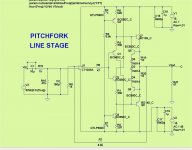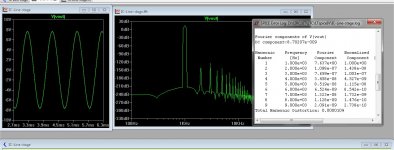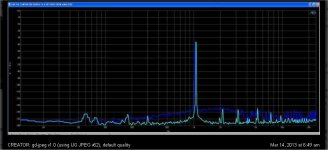I know I might be close to "being in over my head" ....
But that level of challenge is what keeps me going 😀.
The design goals -
PCB 1 = analog
-Analog regulated power supplies.
-IC / discrete class A buffers.
PCB 2/3 = digital
- DAC / clock
- PGA2311 /arduino /LCD display
- of course .... the analog 3.3 , 5V digital supplies.
PS - the PCB being split will allow just a line stage builder
to also take part in the project.
(below 1/2) - the line stage.
10ppb/1k diamond based buffer - 7X gain.
Also , the .asc ...
OS
But that level of challenge is what keeps me going 😀.
The design goals -
PCB 1 = analog
-Analog regulated power supplies.
-IC / discrete class A buffers.
PCB 2/3 = digital
- DAC / clock
- PGA2311 /arduino /LCD display
- of course .... the analog 3.3 , 5V digital supplies.
PS - the PCB being split will allow just a line stage builder
to also take part in the project.
(below 1/2) - the line stage.
10ppb/1k diamond based buffer - 7X gain.
Also , the .asc ...
OS
Attachments
Last edited:
This guys DAC looks neat. http://www.diyaudio.com/forums/digi...-nos-192-24-dac-pcm1794-waveio-usb-input.html I'm not sure if 8 paralleled stereo DAC chips are really needed though.
This guys DAC looks neat. http://www.diyaudio.com/forums/digi...-nos-192-24-dac-pcm1794-waveio-usb-input.html I'm not sure if 8 paralleled stereo DAC chips are really needed though.
Unless you have other needs or idea's ....
DAC goals ...
- based on the PCMxxxx - check this out -
Texas Instruments PCM5102 Series Audio D/A Converter ICs | Mouser
32 bit next gen 1728 (bragging rights !! )
- S/pdif and toslink inputs
- low jitter clock
- DAC buffers , all the datasheets recommend a follower.
- power supplies (onboard).
I'm going to start with a "pcm1794 dac project or kit" google search.
Unless 6$ is too much .... PCM5102 , as well.
OS
Last edited:
I saw the 5102 but it actually doesn't look as good as the 1794. The only thing it does better is it can read 32 bit. It's at the end of it's life cycle too.
Do you want to run it NOS? I found it interesting TI was recommending a Linear buffer over their OPAs in the datasheet I was reading.
Do you want to run it NOS? I found it interesting TI was recommending a Linear buffer over their OPAs in the datasheet I was reading.
Last edited:
I saw the 5102 but it actually doesn't look as good as the 1794. The only thing it does better is it can read 32 bit. It's at the end of it's life cycle too.
Do you want to run it NOS? I found it interesting TI was recommending a Linear buffer over their OPAs in the datasheet I was reading.
A shame , the 5102 has the I/V and output filter integrated ... 1794 does not.
Wonder what else TI has ?
OS
NOS = paralleled dac's using more space and current ??
Sounds like class A (or silver wire/boutique caps) for digital ? 🙄
OS
Sounds like class A (or silver wire/boutique caps) for digital ? 🙄
OS
There's a 5102A to replace the 5102. TI has loads of different DACs. We better do a bunch of research here. It's looking like the 32bit stuff is their lower end lines.
NOS = paralleled dac's using more space and current ??
Sounds like class A (or silver wire/boutique caps) for digital ? 🙄
OS
I've seen a lot of discussion about the NOS thing but don't know much about it. Signal specs look better if they are run in mono but I don't know if it's enough that we could hear.
http://www.ti.com/lit/ds/symlink/pcm1795.pdf
1795/6 have the attenuator built in ,no pga2311 needed !
But they still need the external I/V -filter.
OS
1795/6 have the attenuator built in ,no pga2311 needed !
But they still need the external I/V -filter.
OS
There's a 5102A to replace the 5102. TI has loads of different DACs. We better do a bunch of research here. It's looking like the 32bit stuff is their lower end lines.
No , the 1795 is 32. the 5102 just has the I/V , mute ... everything integrated
into the IC. Most likely geared toward mobile devices.
The lower performance is because of the integrated analog.
Yes , we both have a lot to learn .... drool !
 - give me mo' datasheets.
- give me mo' datasheets.OS
The output buffer isn't a huge issue. I think I'd use a little better op amp though. Here would be the place to use one of your favorite OPAs
The output buffer isn't a huge issue. I think I'd use a little better op amp though. Here would be the place to use one of your favorite OPAs
But it is a big player.
1792 , 1794-6 use differential current outputs.
1791 , 1793 have voltage diff. outputs. (only 1 op-amp for the LPF).
By placing more (or less) of the analog filtering external , different
degrees of "audiophile" precision can be had.
You can design for "mobile device" all the way up to the "drool" level.😀
OS
PCM5102 is looking like the winner to me. Signal is pretty much the same as 1791/3 but it will do 32 bit and doesn't need the extra output buffer. Less pins to connect too.
PCM5102 is looking like the winner to me. Signal is pretty much the same as 1791/3 but it will do 32 bit and doesn't need the extra output buffer. Less pins to connect too.
OK , here is the "nitty gritty" for it ....
PCM5102 Burr-Brown DAC with DIR9001 SPDIF Receiver
-complete with toslink /coax.
- the designer says it is "airy , transparent" ... oh well.
I've also found non-chinese DIY for the 7192/4.
Jeff , above 10K is where the output diff V/I and output LPF refinement
really comes into play. The TI's output is a dirty staircase approximation
of a sine wave (or other waves). The V/I and LPF have the final job
of making this waveform listenable.
The 5102 does this with a 5532 like cheap monolithic setup , and a
virtual negative rail generated within. This is why it is -112db vs >-120
for a 1794.
The "next generation" 5102 is just a move toward the mobile market , not
the performance market. The virtually unusable 32bit interface option is
also a marketing ploy.
Sorry to be this technical , but the datasheets tell it all.
Edit - the 5102 is not THAT bad , it is in the most expensive "pocket dac's" (100 -250$).
Truly a mobile IC !!!
OS
Last edited:
More 5102 "nitty gritty".
Not to denigrate it , we (might) never hear this ... link -
???????????--?????????
Even as it is in Chinese , he brings the output close to 1V for
a -86db thd + noise figure.
Worse than the best case TI documentation.
On the other end of the spectrum (below). Is the ESS9018.
It is like the 1794/5 with it's 3 op-amp V/I -filter.
No on-board charge pump for battery operation.
A 1794/5 circuit would be about in the
middle between the 5102 and ESS9018.
Just a range of options.
OS
Not to denigrate it , we (might) never hear this ... link -
???????????--?????????
Even as it is in Chinese , he brings the output close to 1V for
a -86db thd + noise figure.
Worse than the best case TI documentation.
On the other end of the spectrum (below). Is the ESS9018.
It is like the 1794/5 with it's 3 op-amp V/I -filter.
No on-board charge pump for battery operation.
A 1794/5 circuit would be about in the
middle between the 5102 and ESS9018.
Just a range of options.
OS
Attachments
Last edited:
Going a step further on the design you may want to consider this SMD LME49600 from TI as a buffer…of course it will take the fun out of designing a discrete buffer section but it could be used as a headphone output.
http://www.ti.com/lit/ds/symlink/lme49600.pdf
http://www.ti.com/lit/ds/symlink/lme49600.pdf
Going a step further on the design you may want to consider this SMD LME49600 from TI as a buffer…of course it will take the fun out of designing a discrete buffer section but it could be used as a headphone output.
http://www.ti.com/lit/ds/symlink/lme49600.pdf
That is crazy , the LME's block diagram is the EXACT same as my discrete.
I never saw that design before , but came up with it independently ??
Package is cool too , looks like Jeff's relay Mosfets.
OS
Looks close to the PGA - 10ppm .just to throw something into the mix, maxim makes the DS1808 volume control device. it is just pots and control logic, no internal opamps for those that want to have absolute control over the audio circuits.
Cost is not ridiculous either ...
Might be worth a look.DS1808
mlloyd1
Will consider depending on available resources and sourcing.
PGA seems to be far more used (and abused - by alibaba/ebay 😀).
Edit - HAH ... strange I named it the pitchfork.. It has 3 prongs-pcb'S (DAC /volume/buffers).
OS
- Home
- Source & Line
- Analog Line Level
- Pitchfork pre-amplifier


